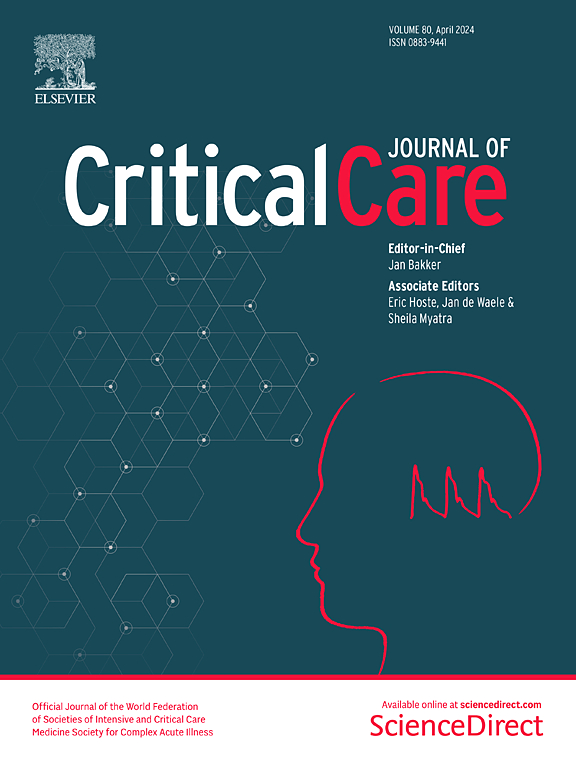在无创脑自动调节指导下,危重患者个体化平均动脉压目标:一项范围综述
IF 8.8
1区 医学
Q1 CRITICAL CARE MEDICINE
引用次数: 0
摘要
目前的指南建议对危重病人实行统一的平均动脉压(MAP)目标;例如,对于脓毒症和心脏骤停患者,65 mmHg。然而,由于患者的大脑自我调节能力可能差异很大,统一的靶标可能不足以维持脑灌注。基于非侵入性脑自动调节的个性化MAP靶点可能优化灌注并减少并发症。本文综述了危重患者个性化MAP靶点的数值、可行性和临床数据。重点是非侵入性监测,如近红外光谱和经颅多普勒超声,因为它们的安全性,实用性和适用于有和没有脑损伤的患者。遵循PRISMA-ScR指南,于2023年9月28日对Ovid MedLine、Embase (Ovid)和Cochrane Library (Wiley)进行了系统检索。两名独立审稿人筛选标题、摘要和全文的资格,并手动审查参考文献。在7738项研究中,49项符合纳入标准。其中,45例(92%)为观察性,4例(8%)为干预性。患者人群包括心脏手术(26.53%)、非心脏大手术(4.8%)、心脏骤停(8.16%)、脑损伤(7.14%)、呼吸衰竭和休克(3.6%)以及败血症(3.6%)。24项研究报告了最佳MAP(49%), 23项研究报告了自动调节下限(47%),10项研究报告了自动调节上限(20%)。34项研究报告了由于软件故障、异常数据、MAP自然波动不足和工作流程障碍导致的部分数据丢失。现有的随机对照试验(RCT)确定了将患者维持在目标范围内的挑战。研究探索了个性化MAP靶点与广泛的神经和非神经预后之间的关联,其中最显著和一致的关联被确定为急性肾损伤和主要发病率和死亡率。10项研究调查了人口统计学预测因素,仅确定了少数个性化目标预测因素。初步调查表明,个性化MAP目标存在相当大的差异,这可能解释了危重患者群体临床结果的差异。关键的差距仍然存在,包括除了心脏手术和精心设计的随机对照试验之外,缺乏对危重亚群的观察性研究。解决已确定的可行性障碍可能是成功开展未来研究的关键。本文章由计算机程序翻译,如有差异,请以英文原文为准。
Individualized mean arterial pressure targets in critically ill patients guided by non-invasive cerebral-autoregulation: a scoping review
Current guidelines recommend a uniform mean arterial pressure (MAP) target for resuscitating critically ill patients; for example, 65 mmHg for patients with sepsis and post-cardiac arrest. However, since cerebral autoregulation capacity likely varies widely in patients, uniform target may be insufficient in maintaining cerebral perfusion. Personalized MAP targets, based on a non-invasive determination of cerebral autoregulation, may optimize perfusion and reduce complications. This scoping review summarizes the numerical values, feasibility, and clinical data on personalized MAP targets in critically ill patients. The focus is on non-invasive monitoring, such as near-infrared spectroscopy and transcranial doppler ultrasound, due to their safety, practicality and applicability to patients with- and without brain injury. Following PRISMA-ScR guidelines, a systematic search of Ovid MedLine, Embase (Ovid), and the Cochrane Library (Wiley) was conducted on September 28, 2023. Two independent reviewers screened titles, abstracts, and full texts for eligibility and manually reviewed references. Of 7,738 studies were identified, 49 met the inclusion criteria. Of these, 45 (92%) were observational and 4 (8%) were interventional. Patient populations included cardiac surgery (26, 53%), non-cardiac major surgery (4, 8%), cardiac arrest (8, 16%), brain injury (7, 14%), respiratory failure and shock (3, 6%), and sepsis (3, 6%). Optimal MAP was reported in 24 (49%), lower limit of autoregulation in 23 (47%), and upper limit of autoregulation in 10 studies (20%). Thirty-four studies reported partial data loss due to software failures, anomalous data, insufficient natural MAP fluctuation, and workflow barriers. Available randomized controlled trials (RCT) identified challenges with maintaining patients within their target range. Studies explored the associations between personalized MAP targets and a wide range of neurological and non-neurological outcomes, with the most significant and consistent associations identified for acute kidney injury and major morbidity and mortality. Ten studies investigated demographic predictors identifying only few predictors of personalized targets. Preliminary investigations suggest considerable variability in personalized MAP targets, which may explain differences in clinical outcomes among critically ill populations. Key gaps remain, including a lack of observational studies in critically ill subpopulations other than cardiac surgery and well-designed RCTs. Resolving identified feasibility barriers might be crucial to successfully carrying out future studies.
求助全文
通过发布文献求助,成功后即可免费获取论文全文。
去求助
来源期刊

Critical Care
医学-危重病医学
CiteScore
20.60
自引率
3.30%
发文量
348
审稿时长
1.5 months
期刊介绍:
Critical Care is an esteemed international medical journal that undergoes a rigorous peer-review process to maintain its high quality standards. Its primary objective is to enhance the healthcare services offered to critically ill patients. To achieve this, the journal focuses on gathering, exchanging, disseminating, and endorsing evidence-based information that is highly relevant to intensivists. By doing so, Critical Care seeks to provide a thorough and inclusive examination of the intensive care field.
 求助内容:
求助内容: 应助结果提醒方式:
应助结果提醒方式:


